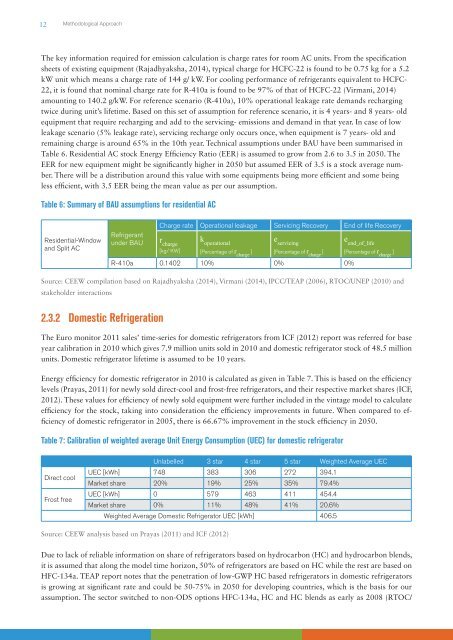Hydrofluorocarbon Emissions-Shakti Sustainable Energy Foundation
One such critically important category of gases is hydrofl uorocarbon (HFC). HFCs are potent greenhouse gases and are expected to contribute signifi cantly to global warming by 2050 (IPCC/TEAP, 2006; Velders et al., 2009; Gschrey et al., 2011; Miller & Kuijpers, 2011; Höglund-Isaksson et al., 2013). Read more information visit: http://shaktifoundation.in/report/indias-long-term-hydrofluorocarbon-hfc-emissions-detailed-cross-sectoral-analysis/
One such critically important category of gases is hydrofl uorocarbon (HFC). HFCs are potent greenhouse gases and are expected to contribute signifi cantly to global warming by 2050 (IPCC/TEAP, 2006; Velders et al., 2009; Gschrey et al., 2011; Miller & Kuijpers, 2011; Höglund-Isaksson et al., 2013). Read more information visit: http://shaktifoundation.in/report/indias-long-term-hydrofluorocarbon-hfc-emissions-detailed-cross-sectoral-analysis/
Create successful ePaper yourself
Turn your PDF publications into a flip-book with our unique Google optimized e-Paper software.
12<br />
Methodological Approach<br />
The key information required for emission calculation is charge rates for room AC units. From the specification<br />
sheets of existing equipment (Rajadhyaksha, 2014), typical charge for HCFC-22 is found to be 0.75 kg for a 5.2<br />
kW unit which means a charge rate of 144 g/ kW. For cooling performance of refrigerants equivalent to HCFC-<br />
22, it is found that nominal charge rate for R-410a is found to be 97% of that of HCFC-22 (Virmani, 2014)<br />
amounting to 140.2 g/kW. For reference scenario (R-410a), 10% operational leakage rate demands recharging<br />
twice during unit’s lifetime. Based on this set of assumption for reference scenario, it is 4 years- and 8 years- old<br />
equipment that require recharging and add to the servicing- emissions and demand in that year. In case of low<br />
leakage scenario (5% leakage rate), servicing recharge only occurs once, when equipment is 7 years- old and<br />
remaining charge is around 65% in the 10th year. Technical assumptions under BAU have been summarised in<br />
Table 6. Residential AC stock <strong>Energy</strong> Efficiency Ratio (EER) is assumed to grow from 2.6 to 3.5 in 2050. The<br />
EER for new equipment might be significantly higher in 2050 but assumed EER of 3.5 is a stock average number.<br />
There will be a distribution around this value with some equipments being more efficient and some being<br />
less efficient, with 3.5 EER being the mean value as per our assumption.<br />
Table 6: Summary of BAU assumptions for residential AC<br />
Residential-Window<br />
and Split AC<br />
Refrigerant<br />
under BAU<br />
Charge rate Operational leakage Servicing Recovery End of life Recovery<br />
r charge<br />
[kg/ KW]<br />
k operational<br />
[Percentage of r charge<br />
]<br />
e servicing<br />
[Percentage of r charge<br />
]<br />
R-410a 0.1402 10% 0% 0%<br />
e end_of_life<br />
[Percentage of r charge<br />
]<br />
Source: CEEW compilation based on Rajadhyaksha (2014), Virmani (2014), IPCC/TEAP (2006), RTOC/UNEP (2010) and<br />
stakeholder interactions<br />
2.3.2 Domestic Refrigeration<br />
The Euro monitor 2011 sales’ time-series for domestic refrigerators from ICF (2012) report was referred for base<br />
year calibration in 2010 which gives 7.9 million units sold in 2010 and domestic refrigerator stock of 48.5 million<br />
units. Domestic refrigerator lifetime is assumed to be 10 years.<br />
<strong>Energy</strong> efficiency for domestic refrigerator in 2010 is calculated as given in Table 7. This is based on the efficiency<br />
levels (Prayas, 2011) for newly sold direct-cool and frost-free refrigerators, and their respective market shares (ICF,<br />
2012). These values for efficiency of newly sold equipment were further included in the vintage model to calculate<br />
efficiency for the stock, taking into consideration the efficiency improvements in future. When compared to efficiency<br />
of domestic refrigerator in 2005, there is 66.67% improvement in the stock efficiency in 2050.<br />
Table 7: Calibration of weighted average Unit <strong>Energy</strong> Consumption (UEC) for domestic refrigerator<br />
Direct cool<br />
Frost free<br />
Unlabelled 3 star 4 star 5 star Weighted Average UEC<br />
UEC [kWh] 748 383 306 272 394.1<br />
Market share 20% 19% 25% 35% 79.4%<br />
UEC [kWh] 0 579 463 411 454.4<br />
Market share 0% 11% 48% 41% 20.6%<br />
Weighted Average Domestic Refrigerator UEC [kWh] 406.5<br />
Source: CEEW analysis based on Prayas (2011) and ICF (2012)<br />
Due to lack of reliable information on share of refrigerators based on hydrocarbon (HC) and hydrocarbon blends,<br />
it is assumed that along the model time horizon, 50% of refrigerators are based on HC while the rest are based on<br />
HFC-134a. TEAP report notes that the penetration of low-GWP HC based refrigerators in domestic refrigerators<br />
is growing at significant rate and could be 50-75% in 2050 for developing countries, which is the basis for our<br />
assumption. The sector switched to non-ODS options HFC-134a, HC and HC blends as early as 2008 (RTOC/

















